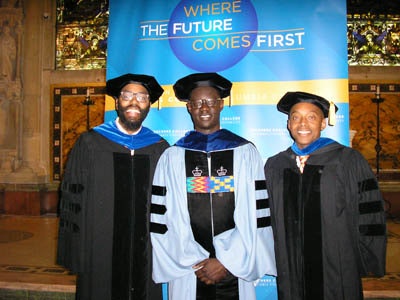NEW YORK — For Dr. Christopher Emdin, watching his former student, Edmund Adjapong, receive his doctoral hood from Teachers College in a ceremony Wednesday was one of the most rewarding moments of his life. The two men share a love of science, teaching and finding innovative ways to engage students of color by using hip-hop and urban culture to forge a connection to the subject matter.
 Dr. Christopher Emdin (left), Dr. Edmund Adjapong (center) and Dr. Khalil Gibran Muhammad, who received the Medal for Distinguished Service, celebrate on Wednesday.
Dr. Christopher Emdin (left), Dr. Edmund Adjapong (center) and Dr. Khalil Gibran Muhammad, who received the Medal for Distinguished Service, celebrate on Wednesday.Currently, a sixth-grade science teacher in the same Bronx, New York neighborhood where he grew up, Adjapong had an early love for science, but negative and dismissive behavior from a middle school science teacher made him push it out of his consciousness. As he detailed in his doctoral dissertation, “Bridging Theory and Practice: Using Hip-Hop Pedagogy as a Culturally Relevant Approach in the Urban Science Classroom,” being in Emdin’s science class in ninth grade reconnected him to the subject.
“He [Emdin] brought science alive for me utilizing hip-hop concepts and bringing hip-hop culture within the classroom,” Adjapong said. “I got to see myself as a scientist, really become engaged and gain the confidence that I could pursue a career in science.”
Emdin transformed abstract concepts into material the students embraced by using creative approaches and showing his students intellectual respect. Adjapong saw himself in the subject matter. It was a class where he and his classmates could be themselves and engage with each other as part of the learning process.
Now an associate professor of science education at Teachers College, Columbia University, Emdin spent a decade teaching in New York City public schools. He experimented with his teaching techniques, initially not knowing how it would impact his students.
Clearly, his concepts worked and Adjapong’s interest in pursuing science in college was cemented. Originally intending to earn a degree in pharmacy, Adjapong switched in his junior year of college and decided to become a teacher.
“I wanted to change the experiences of people just like me in my community and encourage them that they can become scientists and they can engage in science if they so choose,” said Adjapong.
In his classes, Adjapong looks at the five elements of hip-hop: deejaying, emceeing, break dancing, graffiti/visual arts and knowledge of self, noting that students engage in these elements consciously and subconsciously outside of school. He connects these elements to teaching practices, and uses that to connect his students to science.
“The students also curate playlists that we play during independent and group work activities,” he noted. “Students do a lot of visual graffiti art pieces that demonstrate their understanding of science concepts. I’m trying to figure out how to engage students more using technology in the classroom.”
Emdin said his story and Adjapong’s are aligned and probably similar to those of many other people of color, some of whose love of science went unfulfilled.
“I developed [the hip-hop pedagogy] by going into the classroom, teaching math and science, seeing young people disengaged, bored, disinterested, with an absence of passion, and then looking outside my classroom window in the Bronx and seeing young people excited, motivated, supporting each other,” said Emdin. “I wondered why I couldn’t see the same type of passion I saw on the street corner inside the classroom. … I decided I was going to be the person who was going to do it.”
Both Adjapong and Emdin worked full-time as teachers while pursuing their doctorates, which Emdin said is part of being role models. They demonstrated you can be advocates, activists, scientists, educators and students all at once.
“The art of hip-hop means that we hustle, we grind, we put hard work into all that we do and we re-imagine what it can look like,” said Emdin. “You can do all those things concurrently and excellently because they’re all connected.”
Now that Adjapong, who attended Teachers College on the Peter Greeman Scholarship, has received his doctor of science education, he wants to continue his research and figure out ways that students of color can be supported in urban spaces. Just like his mentor, he wants to work in the area of teacher preparation, making sure that teachers are effectively prepared to teach diverse populations. He also wants to make sure that hip-hop is validated in educational spaces and the pedagogy transferred across subjects.
Emdin said that people such as himself and Adjapong must be visible and accessible examples of what is possible. Both are active on social media. For six years they’ve been part of a Twitter chat where participants discuss the intersection of hip-hop and education.
Emdin co-founded Science Genius B.A.T.T.L.E.S (Bringing Attention to Transforming, Teaching and Learning Science) with hip-hip icon GZA. Students are challenged to create science themed raps and participate in a competition judged by rappers and scientists. It began with New York City school kids and has expanded nationally and internationally. Adjapong serves as the project’s director.
“Science Genius is an opportunity for this to not be one thing that happens in one classroom, but rather a larger thing that can happen to as many young people as possible,” said Emdin. “It allows us to expand the reach of the philosophy around the work that we do.
“Edmund has taken Science Genius and run with it,” he added. “It may have been my brain child in theory, but as far as the execution of Science Genius, the communication with young people every day, the structural organization, it has become his project. It’s something that we own together.”





















